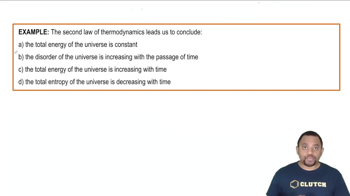Consider the reaction: 2 NO(g) + O2(g) ⇌ 2 NO2(g) The following data show the equilibrium constant for this reaction measured at several different temperatures. Use the data to find ΔH°rxn and ΔS°rxn for the reaction.
Ch.18 - Free Energy and Thermodynamics
Chapter 18, Problem 83a
Determine the sign of ΔSsys for each process. a. water boiling
 Verified step by step guidance
Verified step by step guidance1
Identify the process: Water boiling is a phase change from liquid to gas.
Understand the concept: Entropy (S) is a measure of disorder or randomness in a system.
Recognize that gases have higher entropy than liquids due to increased molecular motion and spacing.
Since water is transitioning from a liquid to a gas, the disorder of the system increases.
Conclude that the sign of \( \Delta S_{sys} \) for water boiling is positive, indicating an increase in entropy.

Verified Solution
Video duration:
51sWas this helpful?
Key Concepts
Here are the essential concepts you must grasp in order to answer the question correctly.
Entropy (ΔS)
Entropy, denoted as ΔS, is a measure of the disorder or randomness in a system. In thermodynamics, an increase in entropy indicates a greater degree of disorder, while a decrease suggests a more ordered state. Understanding how entropy changes during a process is crucial for predicting the spontaneity and direction of chemical reactions.
Recommended video:
Guided course

Entropy in Thermodynamics
Phase Changes
Phase changes, such as boiling, involve transitions between different states of matter (solid, liquid, gas). During boiling, water transitions from a liquid to a gas, which typically results in an increase in entropy due to the greater freedom of movement and arrangement of gas molecules compared to liquid molecules. This concept is essential for analyzing the sign of ΔS in phase transitions.
Recommended video:
Guided course

Entropy in Phase Changes
Second Law of Thermodynamics
The Second Law of Thermodynamics states that the total entropy of an isolated system can never decrease over time. It implies that natural processes tend to move towards a state of maximum entropy. When considering processes like boiling, this law helps predict that the entropy of the system will increase, leading to a positive ΔS for the boiling of water.
Recommended video:
Guided course

Second Law of Thermodynamics Example
Related Practice
Textbook Question
1155
views
1
comments
Open Question
The change in enthalpy (ΔH°rxn) for a reaction is -25.8 kJ/mol. The equilibrium constant for the reaction is 1.4⨉103 at 298 K. What is the equilibrium constant for the reaction at 655 K?
Textbook Question
A reaction has an equilibrium constant of 8.5⨉103 at 298 K. At 755 K, the equilibrium constant is 0.65. Find ΔH°rxn for the reaction.
949
views
Textbook Question
Determine the sign of ΔSsys for each process. b. water freezing
625
views
Open Question
Our atmosphere is composed primarily of nitrogen and oxygen, which coexist at 25 °C without reacting to any significant extent. However, the two gases can react to form nitrogen monoxide according to the reaction: N2(g) + O2(g) → 2 NO(g). a. Calculate ΔG° and Kp for this reaction at 298 K. Is the reaction spontaneous? b. Estimate ΔG° at 2000 K. Does the reaction become more spontaneous as temperature increases?
Textbook Question
Nitrogen dioxide, a pollutant in the atmosphere, can combine with water to form nitric acid. One of the possible reactions is shown here. Calculate ΔG° and Kp for this reaction at 25 °C and comment on the spontaneity of the reaction. 3 NO2(g) + H2O(l)→ 2 HNO3(aq) + NO(g)
1274
views
